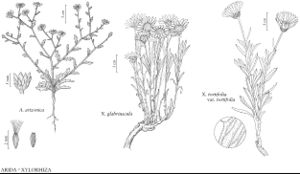Arida arizonica
Sida 20: 1413. 2003.
Annuals, 5–40 cm; taproots slender. Stems usually 1, sometimes 2–6+, erect to ascending, slender, usually much branched from base, divaricately so, densely hispiduloso-glandular, viscid. Leaves basal and cauline; proximal petiolate, distal sessile, often clasping; blades oblanceolate to oblong, reduced distally, 10–50 (–70) × 1–25 mm, herbaceous, margins coarsely dentate or pinnatifid, apices of teeth or lobes spiny-tipped, faces glandular-hispidulous. Heads borne singly (terminal),often in loose, leafy, corymbiform arrays. Involucres hemispheric, 4–5 × 6–8 mm (fresh). Phyllaries in 2–3 series, appressed to reflexed distally, lanceolate, 1–5 mm, bases whitish, margins ± entire, apices green or sometimes purplish, acute, faces hispiduloso-glandular. Ray-florets 20–35+; laminae lavender to whitish, 5–7 mm, coiling after flowering. Disc-florets 25–40+; corollas yellow, 3–6 mm. Cypselae oblanceolate, 1.4–2 mm, smooth, faces sparsely sericeous; pappi: ray 0; disc white, terete, 1.5–3 mm. 2n = 10.
Phenology: Flowering Mar–Nov.
Habitat: Dry, open sandy flats, edges of playas, gravelly washes, riverbanks
Elevation: 70–1000 m
Distribution

Ariz., Calif., Nev., Mexico (Sonora)
Discussion
Arida arizonica is a widespread and variable species recognized by its annual habit, deeply lobed or pinnatifid leaves, dense glandularity, relatively small heads with lavender to whitish ray florets, and absence of pappi on the ray florets.
Selected References
None.
